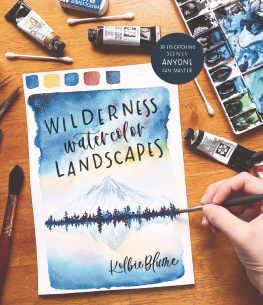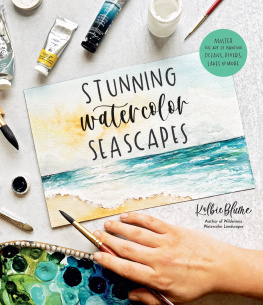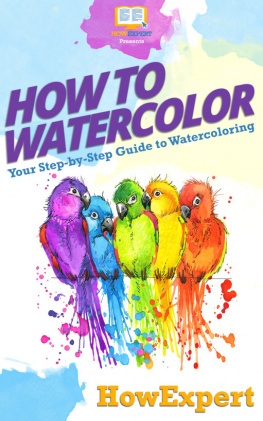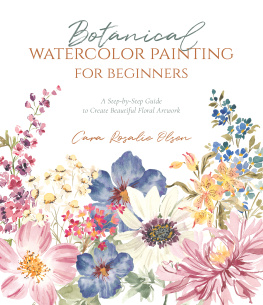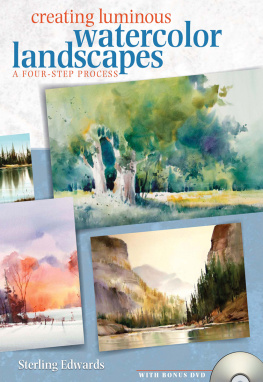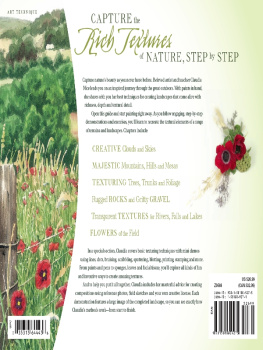Contents
Guide

WILDERNESS
watercolor
LANDSCAPES
30 EYE-CATCHING SCENES ANYONE CAN MASTER
Kolbie Blume

The author and publisher have provided this e-book to you for your personal use only. You may not make this e-book publicly available in any way. Copyright infringement is against the law. If you believe the copy of this e-book you are reading infringes on the authors copyright, please notify the publisher at: http://us.macmillanusa.com/piracy.
Paint-splattered T-shirts. Ink-stained hands. Pencils and brushes barely holding up a nest of messy hair. These are some common calling cards for the stereotypical creative kidsyou know, the kids whose artistic genius seems to be bubbling to the surface, ready to explode at any moment in a cloud of mystery and glitter glue.
I was never one of those kids.
For most of my life, I thought I had my creative outlets coveredand art wasnt one of them. Drawing stick figures was about the extent of my artistic ability and honestly, I was fine with that. That is, until art made its way to Instagram, and all I wanted to do during my lunch breaks at my government job (which I liked) was watch mesmerizing videos of people hand-lettering and painting. I remember spending hours hunched over my iPhone, watching anonymous hands move effortlessly across sketch pads, bringing words and scenery to life right in front of my eyes. After watching each video, my only thought was, Man, I wish I could do that.
But at some point, wishing wasnt enough for me anymore, and my thoughts surprisingly turned into, Why cant I do that? Four years, hundreds of hours, and thousands of pieces of paper laterhere I am, making a career out of a skill I never thought I wanted.
This book is for anyone who has ever studied a landscape watercolor painting and thought to themselves, I wonder how they do that? Its for the creative science major or crafty stay-at-home mom who might live under the false impression that you have to go to art school or have years of experience to create a real painting. For years, I thought artist was a title reserved for a select few in the world, and I would never be one of them. Turns out, I was wrong. If youre someone who has ever told yourself that you cant paint wilderness watercolor scenes, I think youre wrong too. And Im here to help change your mind.
Watercolor is my favorite medium because when I was a beginner with no experience, its innate chaotic structure allowed me to explore without requiring perfection. Loose watercolor is more about guiding the paint than controlling it, allowing you to make paintings with real depth and emotion. With a confident attitude, a passion for breathtaking views, and the right tools, I firmly believe anyone can learn a loose watercolor style that works for them.
Before you begin, I want you to remember that the world is, by nature, imperfect. The last thing you want is to paint a perfect landscape scenebecause those dont actually exist. Now, I cant promise that youll turn into this generations Monet after working through this book. I cant even promise that Im the best teacher for the incredibly daunting journey that is painting the wilderness. What I can promise is that with a little confidence and a lot of practice, you can create something beautiful. Something to be proud of. And I want to help.
When I was in college, I researched creativity for a final paper, and I learned something interesting. According to a study I came across, most adults only have a fourth-grade-level drawing ability because thats the year when many kids tell themselves theyre not good at art. Thinking back on my life, thats almost exactly when I stopped enjoying art projects for precisely that reason. By the time I hit ten years old, it became clear to me that art was a subject I would never perfect, so I stopped trying. The funny thing is that as soon as I took away that negative self-talk at age twenty-three, art wasnt so scary anymore. Turns out, I was actually good at it. Put simply, I went from zero to artist because I chose to believe in myself.
My point is that if you have a hard time believing in yourself, Ive been there. Let me help you by saying, I believe in you. And I cant wait to see what you create.
KB

P.S. Id love to see your progress and cheer you on as you work through this book and beyond! If youre on Instagram and want to share your projects or other creations based on the techniques youve learned, please tag me (@thiswritingdesk) and use the hashtag #WildernessWatercolorClub.
A NOTE ON WORKING THROUGH THIS BOOK
My hope for this book is that it will act as a guide for the beginner watercolor artist as well as a reference book for more seasoned artists looking for new ideas or fun designs. For this reason, well begin by going over the basics of watercolor and wilderness scenes before jumping into projects that range from very simple to fairly complex. Each project will build on the skills youve honed earlier in the book, and the final projects will challenge your newly acquired watercolor skills to paint scenes rich in subject and deptha challenge Im confident youll be well equipped to meet.
I recommend starting at the beginning of this bookespecially if youre just learning about watercolorwhere well get our feet wet with foundational tips and tricks for wilderness landscape painting and watercolor in general. includes everything youll need before you begin painting wilderness scenes, including a list of my favorite materials, in-depth analyses of vital topics, and introductions to essential wilderness elements.
Because Im a firm believer in learning by doing, youll continue by painting 30 carefully curated wilderness landscape scenes. Chapters two through six focus on one of five key wilderness elements (skies, mountains, trees, flowers, and water), each with five unique projects designed to work together to expand your skills and technique, advancing in difficulty as you improve your knowledge and experience. The final chapter, , celebrates your hard work with five final designs of stunning scenes that will challenge you to push what youve learned even further.
To support your practice, each project is broken into achievable steps to help cement the scene-building process.
If you find yourself frustrated or defeated as youre working through this book, know that putting brush to paper at all is an act of courage. Making art is like blending your heart and ego together onto a piece of paper, and it can be scary. But we need art because it brings joyand the best kind of joy comes from the act of making art, not necessarily the end result.
Also, the annoying-but-true fact of life is that you cant get better until you fail enough to realize how to move forward. For me, the goal isnt to create a stunning paintingits cultivating the ability to find joy in the process, regardless of the outcome, and staying curious enough to get better and better every day. Im hoping thats a helpful perspective for you to share.

